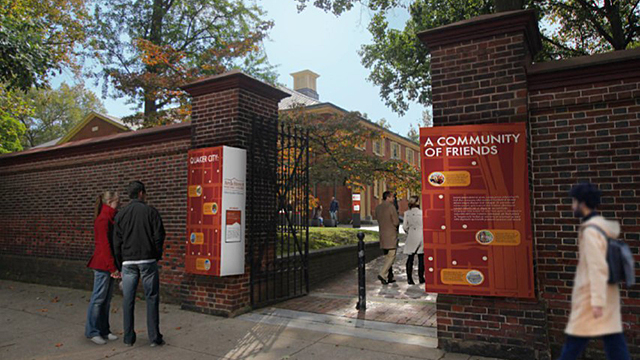
On Friday August 13th Arch Street Meetinghouse Preservation Trust (ASMHT) is organizing a one-day event, from 10:00 AM-3:00 PM, for Friends and the ‘Quaker unaware’ to visit and test out sample exhibit ideas. PYM Friends will help them understand how the exhibits are experienced, and people who are not familiar with the Quaker faith will help them become more aware of Quaker jargon to avoid in the new displays.
Below, the Executive Director of Arch Street Arch Street Meeting House Preservation Trust, Sean Connolly, answers a few questions about the exhibit and what the day will be like.
There has been a lot of research, fundraising and thought that has gone into your outside exhibit project. Tell us what the exhibit prototyping process will add to the eventual installation outcome.
Staff and consultants have spent the last few months writing the exhibit text, carefully reviewing historic site best practices and drafting the feel and look of our new outside exhibits. But the truth of the matter is, we need real people to react to our text and our planned exhibit locations to make sure we’re using easily understandable language, that we are telling stories that will be engaging to the average visitor and that our locations draw people to the site.
Prototyping helps us evaluate our exhibits before we do the expensive work of fabrication, so they really are a very useful data collection tool.
Arch Street is hoping that a good number of people can come and offer their feedback on specific exhibit placement and text. How will you collect and synthesize the take-aways from this work?
Visitors can expect to see Arch Street Meeting House staff and volunteers collecting data by interviewing visitors, conducting surveys and tracking visitors as they walk around the site. We’ll be actively editing the text right there – the same day in real time.
The point of this exercise is to be crossing things out, changing words and moving exhibit panels all day.
At the end of the day, we’ll cross reference all of the surveys and location data points. That information will tell us what our final text and locations should be. Additionally, we’ll be working with our exhibit designer and a museum prototyping expert to crunch these numbers.
You want people to show up, first and foremost. Once they are there, how will you get into the weeds of reviewing each exhibit panel and asking visitors and tourists to give feedback?
First task is to get people onto the Meetinghouse site. We hope that as many people as possible—throughout PYM—will show up so we can make sure we capture that critical Quaker visitor information.
But our team of volunteers, staff and our exhibit consultants will also be pulling visitors and tourists right off the street to try to get them to offer their “hot take” on our exhibits.
We’ll challenge visitors to see if they like our word choice and ask them to offer suggestions or revisions if something is confusing. Our goal is to both dissect our story but also dissect our language.
Once you have that feedback how do you send the exhibit text out for fabrication. Who makes it and how long do you expect it will last before needing updating? Or might there be additions?
After prototyping our team will sit down and do a final revision and edit of the exhibit text. Our exhibit designer will then combine the text and graphic panels.
Exhibitology, an exhibit fabrication company out of New Jersey, will then handle manufacturing—which takes about 2 months. So, we should be looking to actually have permanent exhibits in the ground by early December.
Is there anything else people should know besides planning to stop by to help test the prototypes?
This prototyping day should be really fun, it will be messy – language and the look might change in front of your eyes and because you showed up. That’s the point!
We also want to make sure that everyone can come back in 2022 to see the final product. These exhibits are all about increasing visitation and getting tourists to better understand how Quakers and Arch Street Meeting House have impacted US history and we are so excited to finally be in a position to deliver on that mission.
Featured Photo: Rendering by Metcalfe Architecture & Design, 2020